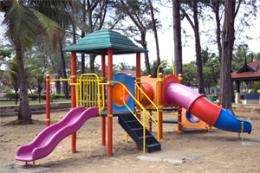Park improvements lead to increased vigorous exercise, not just greater use

A new study suggests that refurbishing neighborhood parks may lead to improvements in community health. Increased visitors and higher rates of exercise were observed for more than one year when one community park provided new and varied amenities.
Study leader Jenny Veitch, Ph.D., of Deakin University in Burwood, Victoria, Australia, notes that it’s no secret that parks can be important places to spend leisure time and for physical activity. However, she says, drawing more people to parks and having them get more exercise there is still largely an unmet public health goal. It’s particularly important to encourage people in disadvantaged neighborhoods to exercise, she adds, where residents are at an increased risk of inactivity, which can lead to poor health.
For their study, Veitch and her colleagues took advantage of changes already scheduled to take place in a local disadvantaged neighborhood. That neighborhood, containing two community parks, had one park scheduled for a significant refurbishment. Before refurbishment, both parks were primarily open spaces, with few amenities. Afterward, the refurbished park would include a dog run, a playground, a 365-meter walking track, a barbeque area, new landscaping, and fencing to prevent motor vehicle access.
Veitch and her colleagues observed visitors at both parks three months before the changes took place, three months afterwards, and then a year later.
The researchers, reporting in the American Journal of Preventive Medicine, found that the number of visitors to the updated park more than quadrupled between the first observation and the last. Moreover, the numbers of people walking or vigorously exercising in the refurbished park similarly grew. While visitorship declined slightly in the other park, it wasn’t nearly enough to account for the number of newcomers to the refurbished park.
Investing in attractive and functional park features could pay off significantly in terms of increasing exercise, leading to positive health consequences for low-income communities, explains Veitch.
“Our previous research has shown parks in low socio-economic areas are of poorer quality compared with parks in higher socio-economic areas,” Veitch adds. “Modifying the built environment by improving park facilities and features is potentially a long term and sustainable way to increase population level physical activity.”
That exercise can improve health is now well established, adds John Librett, Ph.D., a former health scientist with the Centers for Disease Control . However, he says, it’s still unclear whether park visitors continue to return after their initial visits and keep up their workout routines, a necessary step for maintaining health over the long haul.
“This study shows increased park usage, but what we don’t know is whether different people were visiting the park and not returning, or whether the same people were continually using the park every couple of days,” he says. “You have to keep exercising to maintain benefits.”
More information: Veitch, J., et al. (2012). Park Improvements and Park Activity: A Natural Experiment, American Journal of Preventive Medicine, In Press.















